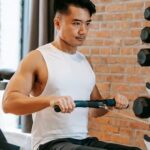Diet and exercise are the pillars of a fitness model’s lifestyle, ensuring they maintain their sculpted physique and peak performance. From meticulously planned meals to intense workout routines, every aspect of their daily routine contributes to their success in the competitive world of fitness modeling.
Fueling their bodies with the right nutrients is crucial for a fitness model to achieve and maintain their desired physique. The nutrition secrets that guide their dietary choices play a significant role in sculpting those enviable muscles and staying lean. Balancing macronutrients like proteins, fats, and carbohydrates along with micronutrients is essential for supporting overall health and performance.
Meal prep becomes a vital component for busy fitness models who are always on the go. By planning ahead and preparing nutritious meals in advance, they can stay on track with their diet goals even during hectic days. Carefully selecting each meal based on its nutritional value ensures that they have the energy needed for intense workouts while keeping their body fat levels in check.
Nutrition Secrets
Nutrition is a crucial component of a fitness model’s regimen, as it plays a significant role in achieving and maintaining a lean and toned physique. A typical diet of a fitness model consists of high-quality proteins, complex carbohydrates, healthy fats, and an abundance of fruits and vegetables. These macronutrients are essential for providing the necessary energy levels to support their rigorous workout routine while aiding in muscle recovery and growth.
Protein sources such as chicken, turkey, fish, eggs, and plant-based proteins like legumes and tofu are staples in a fitness model’s diet. These help in building and repairing muscles after intense training sessions. Carbohydrates from whole grains, sweet potatoes, oats, and quinoa provide the fuel needed for workouts and overall daily activities. Healthy fats from sources like avocados, nuts, seeds, and olive oil are essential for hormone production and maintaining healthy cell function.
In addition to macronutrients, fitness models also prioritize getting an adequate intake of micronutrients through fruits and vegetables. These foods are rich in vitamins, minerals, antioxidants, and fiber that support overall health. By ensuring a well-rounded diet filled with nutrient-dense foods, fitness models can optimize their performance in the gym while promoting overall well-being.
| Nutrition Component | Food Sources |
|---|---|
| Proteins | Chicken, turkey, fish, eggs |
| Carbohydrates | Whole grains, sweet potatoes, oats |
| Healthy Fats | Avocados, nuts, seeds |
| Micronutrients | Fruits and vegetables |
Meal Prep Tips for Busy Fitness Models on the Go
Maintaining a healthy diet and exercise routine is crucial for the success of a fitness model. However, with busy schedules filled with photoshoots, workouts, and other commitments, finding time to prepare nutritious meals can be a challenge. This is where meal prep becomes a lifesaver for busy fitness models on the go.
Planning Ahead
One key tip for successful meal prep as a fitness model is to plan ahead. Take some time at the beginning of each week to plan your meals and snacks. This not only ensures that you have healthy options readily available but also saves you time during hectic days. Consider preparing large batches of staple foods like grilled chicken, roasted vegetables, and quinoa that can easily be portioned out into meals throughout the week.
Invest in Quality Containers
Investing in quality containers for your meal prep is essential for keeping your food fresh and easy to transport. Look for containers that are microwave-safe, leak-proof, and freezer-friendly. Having a variety of sizes on hand will make portioning out meals simpler and more efficient. Additionally, using compartmentalized containers can help you keep different components of your meal separate until it’s time to eat.
Prep Smart Snacks
In addition to preparing main meals, don’t forget to plan for healthy snacks as well. Fitness models often have demanding schedules that leave little time for sit-down meals, making snacks an important part of their nutrition routine. Pack portable snacks like nuts, protein bars, Greek yogurt cups, or cut-up veggies with hummus to fuel your body throughout the day. Having these snacks prepped and ready to grab can prevent unhealthy choices when hunger strikes on-the-go.
By implementing these meal prep tips into their routine, busy fitness models can ensure they stay fueled with nutritious foods even during the busiest of days. Time spent planning and prepping meals ahead of time can lead to better food choices, improved performance in workouts, and ultimately support their overall health and fitness goals.
Importance of Macros and Micros in a Fitness Model’s Diet
As a fitness model, achieving and maintaining a toned physique requires more than just hard work at the gym. The importance of tracking both macronutrients (macros) and micronutrients (micros) in your diet plays a crucial role in reaching your fitness goals. Macros are the macronutrients that provide energy: proteins, carbohydrates, and fats. Meanwhile, micros are essential vitamins and minerals necessary for overall health and optimal performance.
Macros: Fueling Your Workouts
Proteins are the building blocks for muscle growth and repair, making them essential for fitness models who want to sculpt their bodies. Carbohydrates are the body’s primary source of energy, especially during high-intensity workouts, while fats play a vital role in hormone production and overall health. Balancing these macros according to your specific fitness goals is key to optimizing your performance and recovery.
Micronutrients: Supporting Overall Health
While macros provide energy and fuel for workouts, micronutrients are equally important in maintaining overall health and well-being. Nutritional deficiencies can impact muscle recovery, metabolism, and immune function – all critical aspects of a fitness model’s career.
Ensuring you consume an array of fruits, vegetables, whole grains, lean proteins, and healthy fats can help meet the body’s micronutrient needs for optimal performance. Monitoring these micros alongside macros will not only support physical health but also ensure longevity in the competitive world of fitness modeling.
By understanding the importance of balancing both macros and micros in your diet as a fitness model, you can optimize your performance both inside and outside the gym. Fueling your workouts with proper nutrition tailored to your specific goals will not only support muscle growth but also enhance overall health and wellness on your journey to becoming a successful fitness model.
Remember, a well-rounded diet rich in both macronutrients and micronutrients is key to unlocking your full potential as you strive towards peak physical condition.
The Role of Supplements in Enhancing a Fitness Model’s Performance
Supplements play a crucial role in enhancing the performance and results of a fitness model’s diet and exercise regimen. While a balanced diet is essential for providing the necessary nutrients for overall health and fitness, supplements can help fill in any gaps that may be missing from the diet or provide additional support for specific fitness goals.
Protein supplements, such as whey protein powder, are commonly used by fitness models to support muscle recovery and growth after intense workouts. Additionally, branched-chain amino acids (BCAAs) can aid in reducing muscle soreness and fatigue during training sessions.
Another important supplement for fitness models is pre-workout formulas, which often contain ingredients like caffeine, beta-alanine, and creatine to improve energy levels, focus, and performance during workouts. These supplements can help boost intensity and endurance during training sessions, allowing fitness models to push themselves harder and achieve greater results. Post-workout supplements like glutamine or protein shakes are also popular among fitness models to support muscle repair and recovery after exercise.
It’s crucial for fitness models to choose high-quality supplements from reputable brands to ensure safety and efficacy. Consulting with a healthcare professional or nutritionist can help determine which supplements are best suited for individual needs and goals.
While supplements can be beneficial in enhancing performance, they should not replace a well-rounded diet rich in whole foods. When used in conjunction with a balanced diet and regular exercise routine, supplements can be a valuable tool for optimizing the performance of a fitness model.
| Supplement Type | Benefits |
|---|---|
| Protein Supplements | Support muscle recovery & growth |
| Pre-Workout Formulas | Improve energy levels & focus during workouts |
| Post-Workout Supplements | Aid in muscle repair & recovery after exercise |
Workout Schedule
Fitness models are known for their toned and sculpted physique, which is a result of a well-rounded workout schedule that includes both cardio and strength training. Balancing these two aspects is crucial for optimizing muscle growth, burning fat, and improving overall fitness levels. Here are some key components of how a fitness model typically structures their workout schedule:
- Cardiovascular Exercise: Cardio is essential for burning calories, improving heart health, and increasing endurance. Fitness models often incorporate various forms of cardio into their routine, such as running, cycling, swimming, or HIIT (high-intensity interval training). They typically aim for at least 30 minutes to an hour of cardio sessions several times a week to keep their metabolism revved up.
- Strength Training: Building lean muscle mass is vital for increasing metabolism and achieving that coveted toned look. Fitness models usually include weightlifting or bodyweight exercises in their routine to target different muscle groups. They focus on compound movements like squats, deadlifts, lunges, and push-ups to engage multiple muscles simultaneously and maximize efficiency.
- Combination Workouts: To get the best results, fitness models often combine cardio and strength training in the same session. This not only saves time but also creates a more intense workout that challenges both the cardiovascular system and muscles. For example, circuit training or CrossFit-style workouts are popular choices among fitness models.
By incorporating a variety of exercises that target different aspects of fitness, such as endurance, strength, and flexibility, fitness models can maintain a balanced workout schedule that promotes overall health and helps them achieve their aesthetic goals. Additionally, proper recovery through rest days and adequate nutrition is essential to support the demands placed on the body from intense diet and exercise routines.
Recovery and Rest
Rest and recovery are essential components of a fitness model’s routine to ensure optimal performance and results. While intense workouts and strict diets are key to achieving a toned physique, giving the body adequate time to rest and recover is equally important. Here are some reasons why rest days play a crucial role in the overall well-being of a fitness model:
1. Muscle Repair: Rest days allow muscles to repair and rebuild after strenuous workouts. When we exercise, small tears occur in the muscle fibers. Rest days give these fibers time to heal, resulting in stronger and more defined muscles over time.
2. Prevention of Overtraining: Pushing the body too hard without sufficient rest can lead to overtraining, which can have negative effects on both physical and mental health. Symptoms of overtraining include fatigue, increased risk of injury, impaired performance, and mood changes. By incorporating rest days into their routine, fitness models can prevent these issues.
3. Mental Health: Rest days are not only beneficial for physical recovery but also for mental well-being. Constantly pushing oneself through intense workouts without breaks can lead to burnout and decreased motivation. Taking time off from training allows fitness models to reset both physically and mentally, coming back stronger and more focused on their goals.
By prioritizing rest and recovery in addition to their diet and exercise regimen, fitness models can achieve balance in their routine while maximizing results. Incorporating proper sleep, active recovery techniques such as stretching or yoga, and listening to their bodies’ cues can help them maintain peak performance levels while staying healthy in the long run.
Mindset and Motivation
As a fitness model, maintaining a strong and resilient mindset is just as essential as following a strict diet and exercise regimen. The mental aspect of staying motivated and driven is often overlooked but plays a crucial role in achieving fitness goals. It requires discipline, determination, and a positive attitude to stay focused on the journey towards peak physical condition.
One key factor in the mindset of a fitness model is setting clear and attainable goals. Whether it’s improving muscle definition, increasing endurance, or perfecting a competition routine, having specific objectives helps keep motivation high. With each milestone reached, a fitness model gains confidence and momentum to push themselves further.
Additionally, practicing self-care and prioritizing mental well-being are vital components of staying mentally strong as a fitness model. This includes incorporating relaxation techniques such as meditation or yoga into the daily routine, seeking support from peers or mentors in the industry, and recognizing the importance of rest days for both physical and mental recovery.
By nurturing a healthy mindset alongside dedicated diet and exercise routines, a fitness model can truly excel in their craft and achieve their desired physique with confidence.
Frequently Asked Questions
What Is the Diet of a Fitness Model?
As a fitness model, the diet typically consists of lean proteins such as chicken, fish, and tofu, along with complex carbohydrates like brown rice and sweet potatoes. They also incorporate plenty of fresh fruits and vegetables for essential vitamins and minerals. Healthy fats like avocado and nuts are also included to support overall health and energy levels.
How Do Models Eat and Workout?
Models maintain their physique by focusing on a balance of nutritious foods and regular exercise. Their meals consist of whole foods that are minimally processed and full of nutrients.
When it comes to workouts, models often engage in a combination of strength training, cardiovascular exercises, and flexibility work to sculpt their bodies while staying lean. Consistency is key in both diet and exercise routines.
What I Eat in a Day as a Fitness Model?
A typical day of eating for a fitness model includes multiple small meals throughout the day to keep their metabolism revved up and energy levels stable. Breakfast may consist of eggs or Greek yogurt with berries, followed by a mid-morning snack like almonds or a protein shake. Lunch could be grilled chicken with quinoa and vegetables, while an afternoon snack might be sliced apples with nut butter.
Dinner often includes a lean protein source like salmon or turkey with steamed veggies or a salad. Hydration is also crucial, so plenty of water is consumed throughout the day to stay hydrated and aid digestion.

Passionate about providing useful information to anyone with an interest in the field of Personal Training, I strive to pass on to our readers quality information and to answer any questions about Personal Trainers, the work they do and how to become one.





